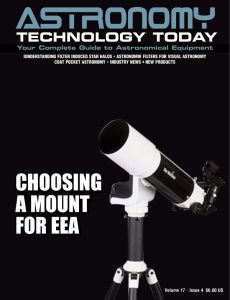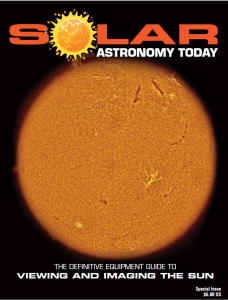Luminos Pro updates offered in Version 10.5 have been announced by the publisher, Wobbleworks. Available on iOS, it offers an all-in-one mobile astronomy app, with a wide range of features for star gazing, observing with a telescope, and exploring the galaxy in 3D. Luminos Pro has vast databases of nearly every type of object and uses them to give custom recommendations for making the most of your time under the sky.
 As the publisher notes, “One key update is the inclusion of a one-time purchase option, which has been integrated in response to valuable user feedback and with a view to making Luminos Pro more accessible, especially to those of you who really (really!) don’t like subscriptions. I am particularly excited to share the new Augmented Reality motion tracking feature, which features graphics overlaid onto live video to identify or find particular objects. All motion tracking modes now include new distinct ‘focus’ modes, so you can now highlight and locate specific categories of celestial objects. For satellite tracking, I have also incorporated automatic labeling of bright satellites, simplifying identifying them too.”
As the publisher notes, “One key update is the inclusion of a one-time purchase option, which has been integrated in response to valuable user feedback and with a view to making Luminos Pro more accessible, especially to those of you who really (really!) don’t like subscriptions. I am particularly excited to share the new Augmented Reality motion tracking feature, which features graphics overlaid onto live video to identify or find particular objects. All motion tracking modes now include new distinct ‘focus’ modes, so you can now highlight and locate specific categories of celestial objects. For satellite tracking, I have also incorporated automatic labeling of bright satellites, simplifying identifying them too.”
He continued, “I’ve also fine-tuned the interface, making it more intuitive and user-friendly with numerous enhancements and additions for an even better user experience. Also, the app’s performance and battery life have been improved to better support all-night observing and for a smoother feel when exploring the galaxy with 3D flight. Additionally, managing custom locations has been streamlined with a new interface and the integration of JSON files, which are conveniently shared automatically between your devices via iCloud Drive, plus they can be generated by you and recognized automatically by the app. I have also added the ability to set the app’s time zone to match your selected location to facilitate easier planning of remote events, or simply for experiencing the night sky from other locations.”
With the Luminos Pro updates users continue to receive easy access to planets and moons, bright star lists, meteor shower charts, 5,000 years of solar and lunar eclipses, constellation details, and if you want to know what or where something in the sky is you just raise your device and motion tracking will identify or locate your target.
Telescope users will appreciate Luminos Pro’s telescope control and equipment management. They can connect to many brands of computer-controlled telescopes for easy pointing directly from Luminos Pro and use the equipment calculator to help choose optimal combinations for your observations. Select a camera and use an accurately scaled overlay on the sky view to calculate the ideal centering and rotation for framing your astrophotography targets.
Luminos Pro also provides an excellent educational experience as it allows users to travel in 3D to see stars in an alien sky, then experience the scale of the space with a seamless 3D flight back home. Luminos Pro makes it fun to explore the planets and moons of the solar system with 100 megapixel maps and complete surface feature databases from the USGS. Users can also explore exoplanets and their star systems, or ride along with a spacecraft like Voyager 1 throughout its journey, or see what the Pleiades looks like when you spin it around in 3D.
Luminos Pro is offered with three subscription options. All subscriptions start with a free month and can be cancelled at any time, even during the free month.
You can learn more about the Luminos Pro Updates here.

 And to make it easier for you to get the most extensive news, articles and reviews that are only available in the magazine pages of Astronomy Technology Today, we are offering a 1-year magazine subscription for only $6! Or, for an even better deal, we are offering 2 years for only $9. Click here to get these deals which only will be available for a very limited time. You can also check out a free sample issue here.
And to make it easier for you to get the most extensive news, articles and reviews that are only available in the magazine pages of Astronomy Technology Today, we are offering a 1-year magazine subscription for only $6! Or, for an even better deal, we are offering 2 years for only $9. Click here to get these deals which only will be available for a very limited time. You can also check out a free sample issue here.
The Sun is more active than it’s been in years and if that’s not enough, we have the Annular Solar Eclipse on October 14, 2023 and the Total Solar Eclipse on April 8, 2024! If you’d like to learn more about the technology behind solar observing, solar imaging and more, you can check out our free publication, “The Definitive Guide to Viewing and Imaging the Sun”. You don’t have to sign up or provide any information, simply click here and enjoy reading!

